

Refrigerated Warehousing Market by Technology, Application, Region. Table of Contents 1 Introduction (Page No. - 16) 1.1 Objectives of the Study 1.2 Market Definition 1.3 Market Scope 1.4 Periodization 1.5 Currency 1.6 Units 1.7 Stakeholders 2 Research Methodology (Page No. - 21) 2.1 Research Data 2.1.1 Secondary Data 2.1.1.1 Key Data From Secondary Sources 2.1.2 Primary Data 2.1.2.1 Breakdown of Primaries 2.1.2.2 Key Industry Insights 2.2 Market Size Estimation 2.2.1 Bottom-Up Approach 2.2.2 Top-Down Approach 2.3 Data Triangulation 2.4 Research Assumptions & Limitations 2.4.1 Assumptions 2.4.2 Limitations 3 Executive Summary (Page No. - 32)
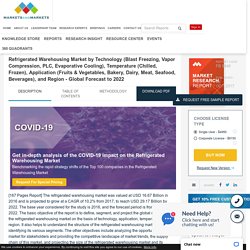
Trends and Analysis. Table of Contents 1 Introduction (Page No. - 14) 1.1 Objectives of the Study 1.2 Stevia Market Definition 1.3 Study Scope 1.4 Periodization Considered for the Study 1.5 Currency Considered 1.6 Units 1.7 Stakeholders 2 Research Methodology (Page No. - 17) 2.1 Research Data 2.1.1 Secondary Data 2.1.1.1 Key Data From Secondary Sources 2.1.2 Primary Data 2.1.2.1 Key Data From Primary Sources 2.1.2.2 Breakdown of Primaries 2.2 Macro Indicators 2.2.1 Increasing Consumer Demand for Natural Sweeteners 2.3 Market Size Estimation 2.3.1 Bottom-Up Approach 2.3.2 Top-Down Approach 2.4 Market Breakdown & Data Triangulation 2.5 Research Assumptions 2.6 Limitations 3 Executive Summary (Page No. - 26) 5 Stevia Market, By Extract Type (Page No. - 44) 5.1 Introduction 5.2 Whole Leaf 5.3 Powdered 5.4 Liquid 6 Stevia Market, By Application (Page No. - 50) 6.1 Introduction 6.2 Dairy 6.3 Bakery & Confectionery 6.4 Tabletop Sweeteners 6.5 Beverages 6.6 Convenience Foods 6.7 Other Applications.
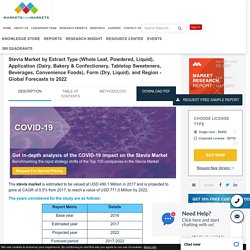
COVID-19 Impact on Yeast Market. 1INTRODUCTION (Page No 19) 1.1Objectives of the Study 1.2Market Definition 1.3Study Scope Figure 1Yeast market segmentation.
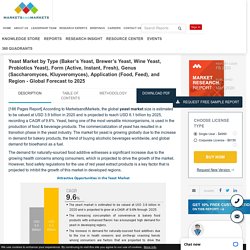
COVID-19 Impact on Agricultural Micronutrients Market. 1 INTRODUCTION (Page No. - 20) 1.1 OBJECTIVES OF THE STUDY 1.2 MARKET DEFINITION 1.3 STUDY SCOPE 1.3.1 REGIONAL SEGMENTATION 1.4 PERIODIZATION CONSIDERED 1.5 CURRENCY CONSIDERED 1.6 UNIT CONSIDERED 1.7 STAKEHOLDERS 2 RESEARCH METHODOLOGY (Page No. - 26) 2.1 RESEARCH DATA 2.1.1 SECONDARY DATA 2.1.1.1 Key Data from Secondary Sources 2.1.2 PRIMARY DATA 2.1.2.1 Key Data from Primary Sources 2.1.2.2 Breakdown of Primaries 2.2 MARKET SIZE ESTIMATION 2.2.1 BOTTOM-UP APPROACH 2.2.2 TOP-DOWN APPROACH 2.3 MARKET BREAKDOWN & DATA TRIANGULATION 2.4 RESEARCH ASSUMPTIONS & LIMITATIONS 2.4.1 ASSUMPTIONS 2.4.2 LIMITATIONS OF THE STUDY 3 EXECUTIVE SUMMARY (Page No. - 35) 4 PREMIUM INSIGHTS (Page No. - 39) 4.1 OPPORTUNITIES IN THE AGRICULTURAL MICRONUTRIENTS MARKET 4.2 AGRICULTURAL MICRONUTRIENTS MARKET, BY FORM 4.3 ASIA PACIFIC: AGRICULTURAL MICRONUTRIENTS MARKET, BY FORM & KEY COUNTRY 4.4 AGRICULTURAL MICRONUTRIENTS MARKET, BY CROP TYPE & REGION 4.5 KEY MARKETS, BY KEY COUNTRY.
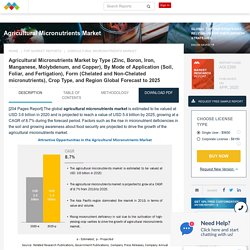
Insect protein industry to be worth $1.3 billion by 2025. According to the new market research report "Insect Protein Market by Insect Type (Crickets, Black Soldier Flies, Mealworms, Ants, and Grasshoppers), Application (Food & Beverages, Animal Nutrition (Aquafeed, Pet Food, and Poultry Feed), Pharmaceuticals & Cosmetics), Region – Global Forecast to 2025," published by MarketsandMarkets, the insect protein market is projected to reach $1.3 billion by 2025, from $144 million in 2019, at a CAGR of 45.0% during the forecast period.
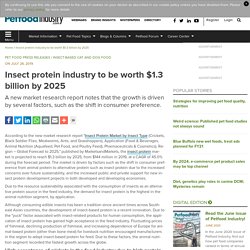
The market is driven by factors such as the shift in consumer preference from animal protein to alternative protein such as insect protein due to the increased concerns over future sustainability, and the increased public and private support for new insect protein development projects in both developed and developing economies. Although consuming edible insects has been a tradition since ancient times across Southeast Asian countries, the development of insect-based protein is a recent innovation. Growth opportunities and latent adjacency in Probiotics Market. The probiotics market is estimated to grow at USD 49.4 billion in 2018 and is projected to grow at a CAGR of 7.0% from 2018, to reach a value of USD 69.3 billion by 2023.
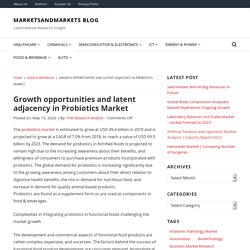
The demand for probiotics in fortified foods is projected to remain high due to the increasing awareness about their benefits, and willingness of consumers to purchase premium products incorporated with probiotics. The global demand for probiotics is increasing significantly due to the growing awareness among customers about their direct relation to digestive health benefits, the rise in demand for nutritious food, and increase in demand for quality animal-based products.Probiotics are found as a supplement form or are used as components in food & beverages. Complexities in integrating probiotics in functional foods challenging the market growth. Growth, Analysis, and Forecast to 2025. Table of Contents 1 Introduction (Page No. - 19) 1.1 Objectives of the Study 1.2 Market Definition 1.3 Study Scope 1.3.1 Regional Segmentation 1.4 Periodization Considered 1.5 Currency Considered 1.6 Stakeholders 2 Research Methodology (Page No. - 23) 2.1 Research Data 2.1.1 Secondary Data 2.1.1.1 Key Data From Secondary Sources 2.1.2 Primary Data 2.1.2.1 Breakdown of Primaries 2.2 Market Size Estimation 2.2.1 Bottom-Up Approach 2.2.2 Top-Down Approach 2.3 Market Breakdown & Data Triangulation 2.4 Research Assumptions & Limitations 2.4.1 Assumptions 2.4.2 Limitations of the Study.
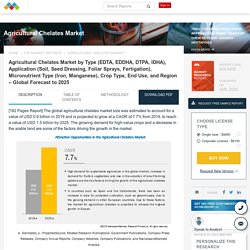
Seed Market Worth $86.0 Billion by 2025 – Exclusive Report by MarketsandMarkets™ – AI industry news. According to the new market research report “Seed Market by Type (Genetically Modified & Conventional), Trait (Herbicide Tolerance, Insect Resistance), Crop Type (Cereals & Grains, Oilseeds & Pulses, Fruits & Vegetables), and Region (NA, EU, APAC, SA, RoW) – Global Forecast to 2025”, published by MarketsandMarkets™, the global Seed Market is estimated to be valued at USD 55.4 billion in 2019 and is expected to reach a value of USD 86.0 billion by 2025, growing at a CAGR of 7.6% during the forecast period.
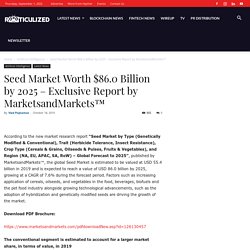
Factors such as increasing application of cereals, oilseeds, and vegetables in the food, beverages, biofuels and the pet food industry alongside growing technological advancements, such as the adoption of hybridization and genetically modified seeds are driving the growth of the market. Download PDF Brochure: The conventional segment is estimated to account for a larger market share, in terms of value, in 2019 Browse in-depth TOC on “Seed Market“ 115 – Tables 69 – Figures226 – Pages. Phytogenic Feed Additives Market Worth $1,226 Million by 2025. CHICAGO, Nov. 15, 2019 /PRNewswire/ -- According to the new market research report "Phytogenic Feed Additives Market by Type (Essential Oils, Flavonoids, Saponins, and Oleoresins), Livestock (Poultry, Swine, Ruminants, and Aquatic Animals), Source (Herbs & Spices, Flowers, and Fruits & Vegetables), Region - Global Forecast to 2025", published by MarketsandMarkets™, the global Phytogenic Feed Additives Market size is projected to reach USD 1,226 million by 2025, which was estimated at USD 701 million in 2019, recording a CAGR of 9.8% from 2019.
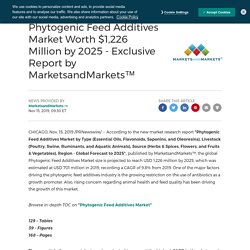
One of the major factors driving the phytogenic feed additives industry is the growing restriction on the use of antibiotics as a growth promoter. Also, rising concern regarding animal health and feed quality has been driving the growth of this market. Browse in-depth TOC on "Phytogenic Feed Additives Market" 129 – Tables 39 – Figures 168 – Pages Essential oils are extracts from particular plants or plant parts. COVID-19 Impact on Feed Market Growth.
1 INTRODUCTION (Page No. - 10) 1.1 COVID-19 HEALTH ASSESSMENT 1.2 COVID-19 ECONOMIC ASSESSMENT 1.2.1 COVID-19 IMPACT ON THE ECONOMY—SCENARIO ASSESSMENT 2 COVID-19 IMPACT ON FOOD, ANIMAL HEALTH, AND AGRICULTURE (Page No. - 16) 2.1 INTRODUCTION 2.2 EFFECT ON GLOBAL MEAT CONSUMPTION 2.3 EFFECTS ON ANIMAL HEALTH 2.4 EFFECTS ON FEED CONSUMPTION 3 COVID-19 IMPACT ON ECOSYSTEM OF FEED INDUSTRY (Page No. - 18) 3.1 VALUE CHAIN 3.2 IMPACT ON VALUE CHAIN 3.2.1 FEED RAW MATERIALS/SUPPLIERS 3.2.2 FEED FORMULATORS 3.2.3 DISTRIBUTION AND LOGISTICS 3.2.4 END-USE INDUSTRY 3.3 MARKET DYNAMICS 3.3.1 DRIVERS 3.3.1.1 Growing awareness regarding animal health & bio-security 3.3.2 RESTRAINTS 3.3.2.1 Impact on feed production and supply chain 3.3.2.2 Impact on demand for meat, dairy, and animal products 9 APPENDIX (Page No. - 58) 9.1 INSIGHTS OF INDUSTRY EXPERTS 9.2 DISCUSSION GUIDE 9.3 KNOWLEDGE STORE: MARKETSANDMARKETS’ SUBSCRIPTION PORTAL 9.4 AUTHOR DETAILS.
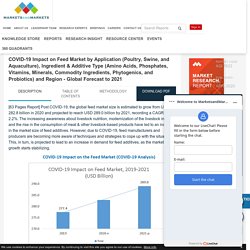
COVID-19 Impact on Agricultural Microbials Market. 1 INTRODUCTION (Page No. - 21) 1.1 OBJECTIVES OF THE STUDY 1.2 MARKET DEFINITION 1.3 STUDY SCOPE 1.4 PERIODIZATION CONSIDERED 1.5 CURRENCY CONSIDERED 1.6 STAKEHOLDERS 2 RESEARCH METHODOLOGY (Page No. - 26) 2.1 RESEARCH DATA 2.1.1 SECONDARY DATA 2.1.1.1 Key Data from Secondary Sources 2.1.2 PRIMARY DATA 2.1.2.1 Key Data from Primary Sources 2.1.2.2 Breakdown of Primaries 2.2 MARKET SIZE ESTIMATION 2.2.1 BOTTOM-UP APPROACH 2.2.2 TOP-DOWN APPROACH 2.3 MARKET BREAKDOWN & DATA TRIANGULATION 2.4 RESEARCH ASSUMPTIONS & LIMITATIONS 2.4.1 ASSUMPTIONS 2.4.2 LIMITATIONS OF THE STUDY 3 EXECUTIVE SUMMARY (Page No. - 34) 4 PREMIUM INSIGHTS (Page No. - 40) 4.1 OPPORTUNITIES IN THE AGRICULTURAL MICROBIALS MARKET 4.2 AGRICULTURAL MICROBIALS MARKET, BY FORMULATION 4.3 NORTH AMERICA: AGRICULTURAL MICROBIALS MARKET, BY KEY COUNTRY & TYPE 4.4 AGRICULTURAL MICROBIALS MARKET, BY CROP TYPE & REGION 4.5 AGRICULTURAL MICROBIALS MARKET: MAJOR REGIONAL SUBMARKETS LIST OF TABLES (121 Tables)
Industry Trends, Insights & Statistics. 1 INTRODUCTION (Page No. - 33) 1.1 OBJECTIVES OF THE STUDY 1.1.1 MARKET INTELLIGENCE 1.1.2 COMPETITIVE INTELLIGENCE 1.2 MARKET DEFINITION 1.3 STUDY SCOPE FIGURE 1 FEED ENZYMES MARKET SEGMENTATION FIGURE 2 REGIONAL SEGMENTATION 1.4 PERIODIZATION CONSIDERED 1.5 CURRENCY CONSIDERED TABLE 1 USD EXCHANGE RATES, 2014–2018 1.6 UNITS CONSIDERED 1.7 STAKEHOLDERS 2 RESEARCH METHODOLOGY (Page No. - 37) 2.1 RESEARCH DATA FIGURE 3 FEED ENZYMES MARKET: RESEARCH DESIGN 2.1.1 SECONDARY DATA 2.1.2 PRIMARY DATA 2.1.2.1 Breakdown of Primary Interviews FIGURE 4 BREAKDOWN OF PRIMARY INTERVIEWS: BY COMPANY TYPE, DESIGNATION, AND REGION 2.2 MARKET SIZE ESTIMATION FIGURE 5 MARKET SIZE ESTIMATION METHODOLOGY: BOTTOM-UP APPROACH FIGURE 6 MARKET SIZE ESTIMATION METHODOLOGY: TOP-DOWN APPROACH 2.3 DATA TRIANGULATION FIGURE 7 DATA TRIANGULATION METHODOLOGY 2.4 RESEARCH ASSUMPTIONS 2.5 LIMITATIONS.
Fungicides Market. Table of Contents 1 Introduction (Page No. - 21) 1.1 Objectives of the Study 1.2 Market Definition 1.3 Study Scope 1.3.1 Regional Segmentation 1.3.2 Periodization Considered 1.4 Currency Considered 1.5 Stakeholders 2 Research Methodology (Page No. - 27) 2.1 Research Data 2.1.1 Secondary Data 2.1.1.1 Key Data From Secondary Sources 2.1.2 Primary Data 2.1.2.1 Key Data From Primary Sources 2.1.2.2 Breakdown of Primaries 2.2 Market Size Estimation 2.2.1 Bottom-Up Approach 2.2.2 Top-Down Approach 2.3 Market Breakdown & Data Triangulation 2.4 Research Assumptions & Limitations 2.4.1 Assumptions 2.4.2 Limitations of the Study 3 Executive Summary (Page No. - 35)
Biopesticides Market Worth $8.5 Billion by 2025. CHICAGO, June 12, 2020 /PRNewswire/ -- According to the new market research report "Biopesticides Market by Type (Bioinsecticides, Biofungicides, Bionematicides, and Bioherbicides), Source (Microbials, Biochemicals, and Beneficial Insects), Mode of Application, Formulation, Crop Application, and Region - Global Forecast to 2025", published by MarketsandMarkets™, the global Biopesticides Market size is projected to grow at a CAGR of 14.7% from an estimated value of USD 4.3 billion in 2020 to reach USD 8.5 billion by 2025.
The market is driven by factors such as an increase in area under of organically grown crops, growth in concerns regarding the hazards of using pesticides, demand for residue-free high-value crops, gradual phase-out of key active ingredients, and government policies are favoring the implementation of biopesticides. Download PDF Brochure: Fruits & vegetables are estimated to form the largest segment among crop types among the biopesticides market.
COVID-19 Impact on Biopesticides Market. 1 INTRODUCTION (Page No. - 22) 1.1 OBJECTIVES OF THE STUDY 1.2 MARKET DEFINITION 1.3 STUDY SCOPE 1.4 INCLUSIONS & EXCLUSIONS 1.5 PERIODIZATION CONSIDERED 1.6 CURRENCY CONSIDERED 1.7 STAKEHOLDERS 1.8 SUMMARY OF CHANGES 2 RESEARCH METHODOLOGY (Page No. - 28) 2.1 RESEARCH DATA 2.1.1 SECONDARY DATA 2.1.1.1 Key Data from Secondary Sources 2.1.2 PRIMARY DATA 2.1.2.1 Key Data from Primary Sources 2.1.2.2 Breakdown of Primaries 2.2 MARKET SIZE ESTIMATION 2.2.1 BOTTOM-UP APPROACH 2.2.2 TOP-DOWN APPROACH 2.3 MARKET BREAKDOWN & DATA TRIANGULATION 2.4 RESEARCH ASSUMPTIONS & LIMITATIONS 2.4.1 ASSUMPTIONS 2.4.2 LIMITATIONS OF THE STUDY 3 EXECUTIVE SUMMARY (Page No. - 37) 4 PREMIUM INSIGHTS (Page No. - 41) 4.1 OPPORTUNITIES IN THE MARKET 4.2 BIOPESTICIDES MARKET, BY SOURCE 4.3 SOUTH AMERICA: BIOPESTICIDES MARKET, BY COUNTRY AND KEY TYPE 4.4 BIOPESTICIDES MARKET, BY TYPE AND REGION 4.5 BIOPESTICIDES MARKET: MAJOR REGIONAL SUBMARKETS LIST OF TABLES (118 Tables)
Food Flavors Market Worth $20.7 Billion by 2025. Dairy Alternatives Market Worth $36.7 Billion by 2025. COVID-19 Impact on Dairy Alternatives Market. Food Flavors Market Size, Share and Forecast to 2025. Beer Processing Market by Brewery Type, Beer Type, Distribution Channel and Region - 2025. Mushroom Cultivation Market Growth, Size & Share.
Pea Protein Market - Emerging Opportunities, Trends, & Size. Scope, Size, Share and Market Forecast to 2025. Fungicides Market by Type & Region. Beer Processing Market Worth $815.4 Billion by 2025. Blockchain in Agriculture Market (and Food Supply Chain) by Application, Provider, Organization Size, and Region. Environmental Testing Market Worth 12.75 Billion USD by 2022. COVID-19 Impact on Yeast Market. Fermented Ingredients Market Size, Share. Food Thickeners Market by Type, Application, Region. Industry Statistics & Insights. COVID-19 Impact on Feed Market Growth. Food Allergen Testing Market by Source, Technology, Region. Global Aseptic Processing Market Analysis, Size, Share, and Forecast 2022.
Shortenings Market by Key Ingredient, Source, Region. Insect Pest Control Market Analysis & Industry Outlook. Cold Chain market worth 293.27 billion USD by 2023 explored in latest research. Beneficial Insects (Macrobials) Market by Type & Region - Global Forecast 2022. Global Food Waste Management Market Size. Industrial Margarine Market by Type & Application. Global Agricultural Fumigants Market Size, Share, and Forecast 2017. Seed Market by Type, Trait, Crop Type, and Region. Vitamin D Market by Analog, Application, Region - 2025. Nutraceutical Products Market by Type, Source, Distribution Channel, Region - 2025.
Food Safety Testing Market by Target Tested, Food Tested, and Region. Mushroom Cultivation Market to Showcase Continued Growth in the Coming Years – Northern India Herald. COVID-19 Impact on Savory Ingredients Market. The microencapsulated pesticides market is projected to reach 539.5 Million by 2022. Irrigation Controllers Market by Type & Product. Global Food Testing Kits Market Share, Size, Analysis, and Forecast 2022. Textured Soy Protein Market Size, Share. Probiotics Market by Ingredient, Form, Application, End User, Region. Protective Cultures Market Worth $292 Million by 2023. COVID-19 Impact on Seed Treatment Market. COVID-19 Impact on Yeast Market. Egg Replacers Market Report - Global Forecast to 2022. Astaxanthin Market Growth, Size & Share. Baking Ingredients Market Worth 16.91 Billion USD by 2022. Bionematicides Market by Type & Form - Global Forecast 2021. Blockchain in Agriculture Market (and Food Supply Chain) by Application, Provider, Organization Size, and Region.
Food Deaerators Market by Application, Function, Type and Region. Feed Enzymes Market Worth $2.0 Billion by 2025. Bitterness Suppressors and Flavor Carriers Market by Form, Category, Application, Flavor Type and Region. Industrial Margarine Market by Type & Application. Microencapsulated Pesticides Market by Type & Application.
Textured Soy Protein Market by Application, Type, Source, and Region - 2022. COVID-19 Impact on Feed Market - Market Research Reports & Consulting. Stevia Market by Extract Type, Application, Region. Turf Protection Market Analysis, Size, Share and Global Forecast 2022. Non-Thermal Processing Market for Food by Food Type, Technology, Region. Larvicides Market by End-use Sector - Global Forecast 2023. Antifreeze Proteins Market by End Use & Type - Global Forecast 2023. Pet Food Ingredients Market Size, Share. Feed Additives Market Worth $44.3 Billion by 2023. Dairy Alternatives Market Size. Feed Enzymes Market by Type, Livestock, Source, and Region - Forecast to 2025.
Growth Strategies Adopted by Major Players in Probiotics Market. Nutraceutical Ingredients Market Worth $228.0 Billion by 2025 - Exclusive Report by MarketsandMarkets™ Industry Statistics & Insights. Molecular Breeding Market by Process, Marker, Application and Region. Mycotoxin Testing Market by Type, Technology, Region. Agricultural Microbials Market Worth $11.6 Billion by 2025. Covid-19 Impact on the Antimicrobial Packaging Market. COVID-19 IMPACT ON CLEAN LABEL AND FREE FROM PRODUCTS. Covid-19 Impact on Food Automation and Robotics Market. Impact Of Covid-19 On Food Trade With China.
Covid-19 Impact on the Antimicrobial Packaging Market. How will COVID-19 impact Food Safety Testing Market. Nutraceuticals & Dietary Supplements Market Research Reports & Consulting. The Impact of COVID-19 on the Cold Chain Market - Frozen Food Europe. How will COVID-19 impact Personalized Nutrition Market. Miticides Market - Global Industry Trends and Forecast to 2023. Feed Phosphates Market Growth Analysis, Size, and Forecast to 2024. Prepared Food Equipment Market by Type, Application, Region. Known and Unknown Adjacencies Impacting the Insect Protein Market in Coming Years. Starch Recovery Systems Market By Component, Plant size, Application, and Region.
Bottled Water Processing Market by Technology, Equipment, and Region. COVID-19 Impact on Agricultural Microbials Market. Forage Analysis Market Worth $661.1 Million by 2023. Biopesticides Market Worth $6.4 Billion by 2023.